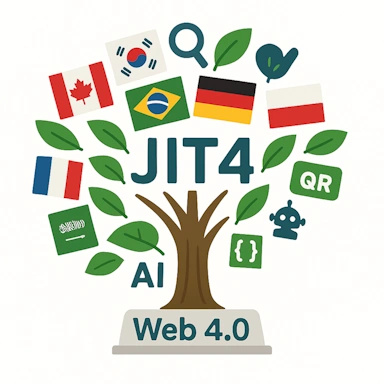Why this (bridge from Web 5)
Web 5 made sentences addressable and verifiable, turning pages into proofs. What still blocks speed is
assembly: picking, wiring, localizing—and later switching—SaaS. Web 6 (MM3) organizes the ecosystem so
assembling capability is routine, not heroic.
Radical proviso (scope & aim)
Scope: Public-facing, SELLING websites.
Aim: Make the open web commercially usable fast—without redesigns—by combining a SaaS-first spine with a thin portability layer for exact, verifiable truth.
One-line statement
MM3 is an open operating model where SaaS publish to shared standards and a Super-Administrator AI (under the site owner’s control) composes, upgrades, and swaps services to the latest web protocols—with a cart of add-ons—so a selling site can be operational the same day (research target), with truth that stays portable.
Normative requirements (strengthening Web 6)
- W6-N1 — Contract-first SaaS. Capabilities, regions/locales, pricing/limits, SLAs, and exit paths MUST be machine-readable and versioned.
- W6-N2 — Portability of truth. Buyer-relevant claims MUST be addressable at the sentence level and verifiable after edits/migrations.
- W6-N3 — Protocol Adaptation. A layer MUST adapt vendor contracts to current web protocols while preserving backward compatibility.
- W6-N4 — Governed automation. A site
charter (consent, limits, locales, privacy) MUST govern all automated composition.
- W6-N5 — Reversibility. Every install MUST produce export & rollback plans before go-live; links, carts, and proofs MUST survive swaps.
What MM3 actually does (under guidance)
- Recommends a stack (payments, tax, search, shipping, analytics, translation, loyalty) that fits goals and locales.
- Adapts vendor contracts to the current protocol set; enforces exact-line landing, verification, and drift signaling.
- Localizes to line-true equivalents; labels fallbacks; aligns glossary terms.
- Stages installs and vendor swaps; simulates outages; shows TCO and exit paths.
- Maintains proofs and publishes small changefeeds; logs time-to-clarity and verified-link events.
Human remains in charge: propose → review → stage → ship (approval gates at each step).
Happy-path sequence (ASCII)
Owner (charter, goals, locales)
└─► Super-Admin AI (governed)
├─ compose stack (SaaS add-ons)
├─ adapt to current protocols
├─ enforce exact-line proof & drift
├─ map locales (line-true), label gaps
├─ stage installs & swaps; simulate
└─ emit changefeeds & metrics
▼ (approval gates)
Runtime (site + services)
├─ open correct UI state; highlight
└─ process orders; keep proofs intact
▼
Users / Agents / Regulators land on the exact line, anywhere
What can be injected (extensibility)
- Verification: semantic-drift classifiers; severity badges.
- Locale: glossary alignment; deterministic fallbacks with visible labels.
- SaaS edges: payments failover, regional tax engines, swappable search without breaking links.
- Governance: bot identity, rate limits, audit trails; CSP/Permissions-Policy compliance.
- Accessibility: focus/ARIA/live-region; reduced motion; high-contrast highlights.
Why people would want this
- Users: one click to the sentence that matters, in their language, with visible recency.
- Tiny teams: no redesign; approve changes; automate the toil.
- Executives: forwardable proofs; measurable truth; reversible adoption.
- Vendors: easier trials; safer switching; global fit.
- Regulators: provenance and change visibility at the claim level.
Acceptance criteria (MM3 over MM2)
- Time-to-deploy: hours, not weeks (same-day as a research target).
- Time-to-clarity: ≤ 3s to the answering sentence (open state + highlight).
- Verified-link rate: ≥ 95% through edits/migrations.
- Movement cost: vendor swap measured in hours, with carts & proofs intact.
- Locale parity: ≥ 95% for mapped lines (gaps labeled).
- Zero hostage UX: installs/upgrades don’t break links or checkout.
Safety & governance
- Human-in-the-loop: staged approvals; reversible deploys.
- Privacy: charter-driven data movement; least privilege; no fingerprinting.
- Security: CSP-friendly; deterministic fallbacks; signed audit logs.
- Internationalization: line-true first; labeled fallbacks; glossary control.
- Open governance: public specs, versioned tests, conformance proofs.
Browser path
Today: ships as a tiny JS/edge layer (progressive enhancement). Tomorrow: candidates for native adoption—content-addressed fragments with short-hash verify, standard open-and-highlight hints, sentence-level changefeeds, and locale-true resolution.
Tagline: Browser-ready today · Browser-native tomorrow.
